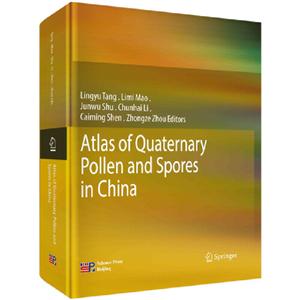Atlas of quaternary pollen and spores in China(中国第四纪孢粉图鉴)
目录
ContentsForeword 1Foreword 2Foreword 3PrefaceChapter 1 Overview of Modern and Quaternary Vegetation in China1.1 Northwest Region Lingyu Tang and Caiming Shen (2)1.1.1 Overview of modern vegetation (3)1.1.1.1 Gobi Desert in eastern Xinjiang (3)1.1.1.2 Extremely arid desert scrub in the Qaidam Basin (3)1.1.1.3 Arid desert scrub and semi-scrub in the Hexi Corridor (3)1.1.1.4 Forest-steppe and pine-oak forest in a temperate semi-humid and semi-arid transition zone of monsoon climate in the Loess Plateau (3)1.1.2 Overview of Quaternary vegetation (4)1.1.2.1 Vegetation and environment since the early Pleistocene in Qinghai region (4)1.1.2.2 Holocene steppe/meadow succession in the northern Tibetan Plateau (9)1.1.2.3 Vegetation and environment since the late Pleistocene in the Loess Plateau (11)1.1.2.4 Vegetation and environment since the early Pleistocene in Xinjiang (14)1.2 North Region Lingyu Tang, Chunhai Li and Caiming Shen (21)1.2.1 Overview of modern vegetation (21)1.2.1.1 Temperate coniferous and broadleaved mixed forest and meadow steppe in Northeast China (21)1.2.1.2 Valley oak forest, Pinus tabulaeformis forest, and shrub steppe in Liaohe River Plain, North China Plain, South Shanxi Plain, and Central Shaanxi Plain (23)1.2.2 Overview of Quaternary vegetation (25)1.2.2.1 Vegetation and environment since the early Pleistocene in the North China Plain (26)1.2.2.2 Vegetation and environment since the early Pleistocene in Northeast China (27)1.3 Southeast Region Junwu Shu, Lingyu Tang and Caiming Shen (36)1.3.1 Overview of modern vegetation (36)1.3.2 Overview of Quaternary vegetation (39)1.3.2.1 Vegetation succession since the mid-Pleistocene in Hubei (39)1.3.2.2 Vegetation and environment since the late Pleistocene in the lower valley of the Yangtze River (41)1.3.2.3 Forest succession since the last glaciation in the coastal region of Fujian (45)1.3.2.4 Vegetation and environment since the late Pleistocene in central Taiwan Island (47)1.4 South Region Limi Mao, Lingyu Tang and Caiming Shen (52)1.4.1 Overview of modern vegetation (52)1.4.1.1 Vegetation in the southern zone of middle subtropical evergreen broadleaved forests (52)1.4.1.2 Vegetation in the southern subtropical monsoonal evergreen broadleaved forest zone (53)1.4.1.3 Tropical semi-evergreen monsoonal forest and tropical monsoonal forest (53)1.4.2 Overview of Quaternary vegetation (55)1.4.2.1 Vegetation since the late Pleistocene in the Pearl River Delta and Chaoshan Plain (55)1.4.2.2 Vegetation and climate since the late Pleistocene in Leizhou Peninsula and Holocene vegetation and climate in Hainan Island (62)1.4.2.3 Late Quaternary pollen and spores, vegetation and climate records in the South China Sea (67)1.4.2.4 Vegetation and climate since the late Pleistocene in Hong Kong (78)1.5 Southwest Region Junwu Shu, Lingyu Tang and Caiming Shen (78)1.5.1 Overview of modern vegetation (78)1.5.1.1 Evergreen broadleaved forest in the Yunnan-Guizhou Plateau and western Sichuan Plateau (78)1.5.1.2 Vegetation dominated by coniferous forests in the southeastern part of the Tibetan Plateau (80)1.5.2 Overview of Quaternary Vegetation (81)1.5.2.1 Quaternary vegetation in northwestern Yunnan (81)1.5.2.2 Quaternary vegetation and monsoonal climate history in western and southcentral Yunnan (84)1.5.2.3 Vegetation since the mid-Pleistocene in western Sichuan (89)1.5.2.4 Quaternary vegetation and environment in Guizhou (91)1.5.2.5 Vegetation and monsoonal climate history since the late Pleistocene in southeastern Xizang (93)Chapter 2 Major Types of Quaternary Pollen and Spores and Their Characteristics in Different Regions of China2.1 Northwest Region Lingyu Tang, Limi Mao and Caiming Shen (100)2.1.1 Types of Quaternary pollen and spores in northwest region (100)2.1.2 Identifiable features of major Quaternary pollen and spores in northwest region (100)2.1.2.1 Identifiable features of main pollen types of Compositae (100)2.1.2.2 Identifiable features of Artemisia, Tamarix, and Zygophyllum pollen (104)2.1.2.3 Identifiable features of Rhamnus, Hippophae, and Elaeagnus pollen (104)2.1.3 Descriptions of morphological features for major Quaternary pollen and spores in northwest region (104)2.1.3.1 Photomicrographs of major Quaternary pollen types in northwest region (104)2.1.3.2 Descriptions of morphological features of major Quaternary pollen types in northwest region (104)2.2 North Region Lingyu Tang and Caiming Shen (108)2.2.1 Types of Quaternary pollen and spores in north region (108)2.2.2 Identifiable feature of major Quaternary pollen types in north region (109)2.2.2.1 Identification key of pollen morphology to the genera of Pinaceae (109)2.2.2.2 Identifiable features of pollen morphology for the genera of Be
封面

书名:Atlas of quaternary pollen and spores in China(中国第四纪孢粉图鉴)
作者:Lingyu Tang[等]editor
页数:15,599页
定价:¥798.0
出版社:科学出版社
出版日期:2019-01-01
ISBN:9787030624345
PDF电子书大小:147MB 高清扫描完整版
